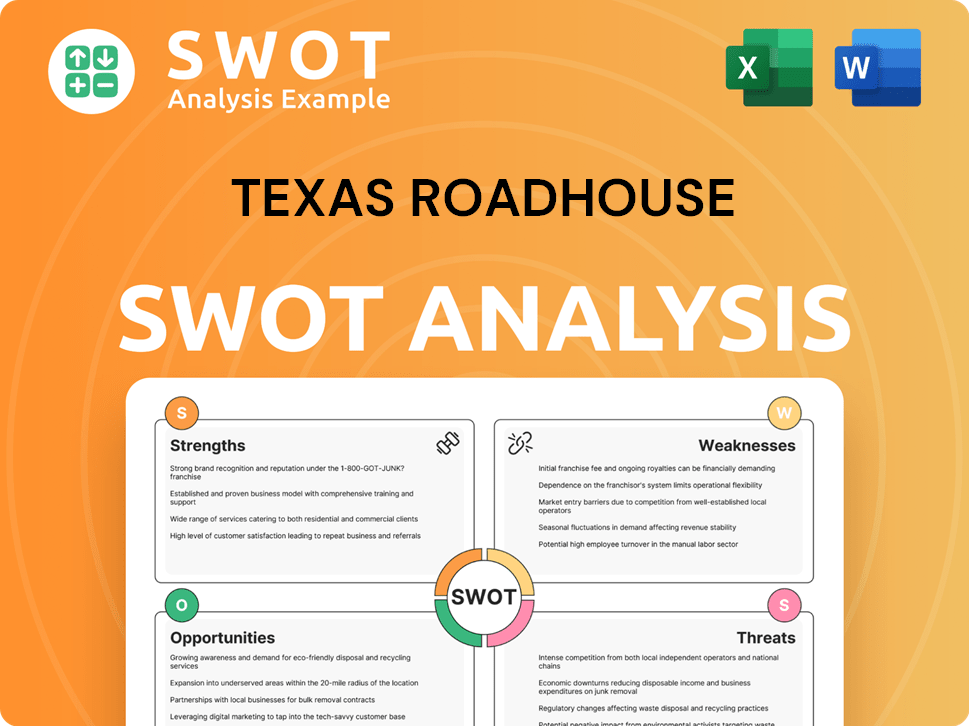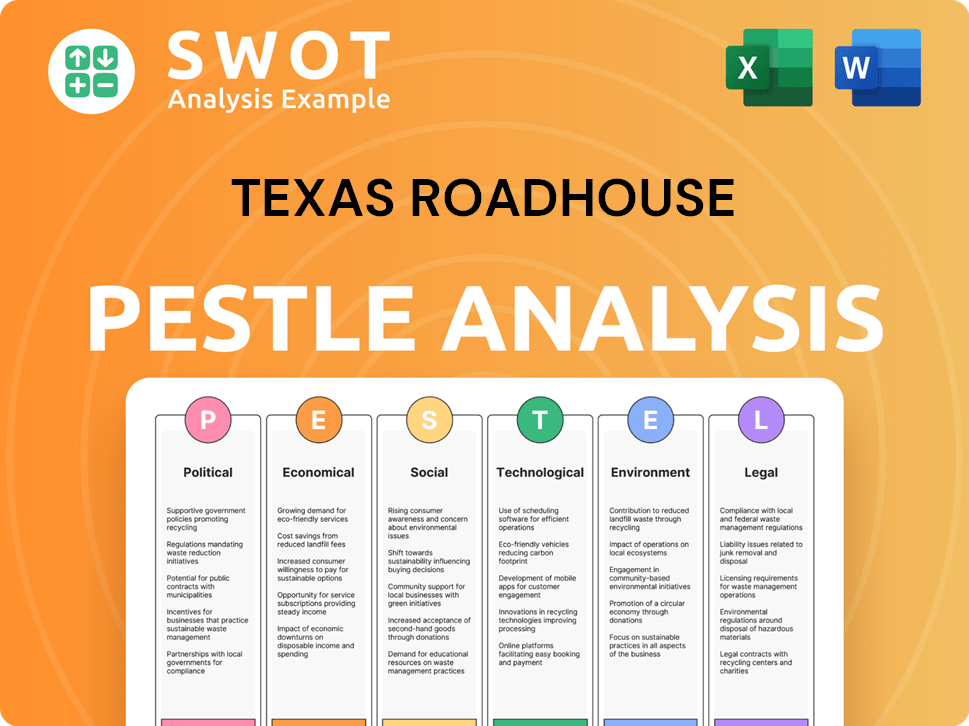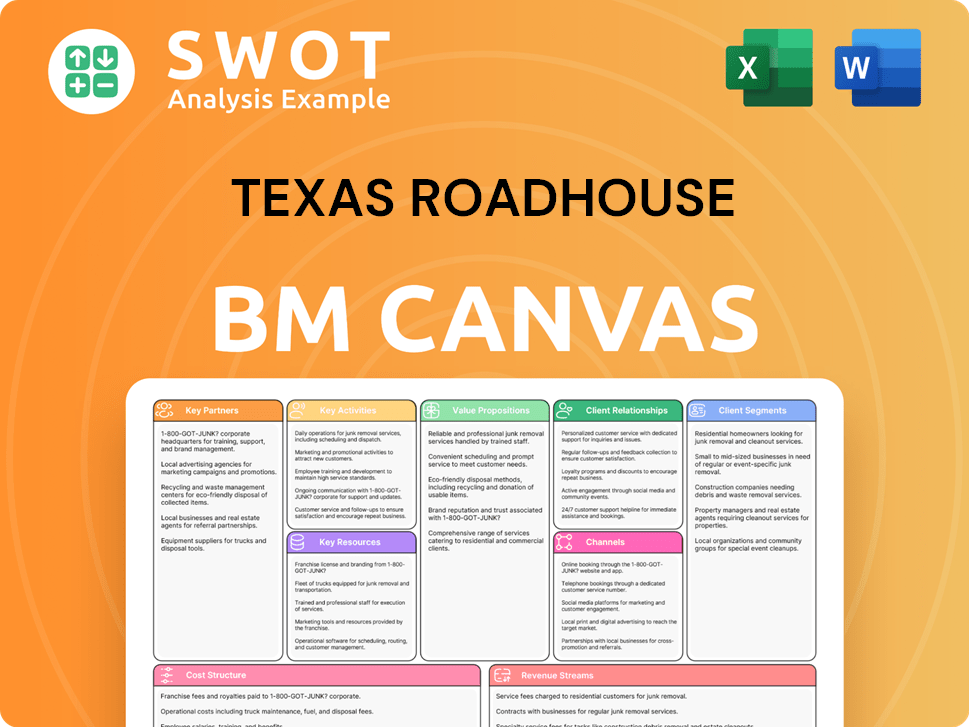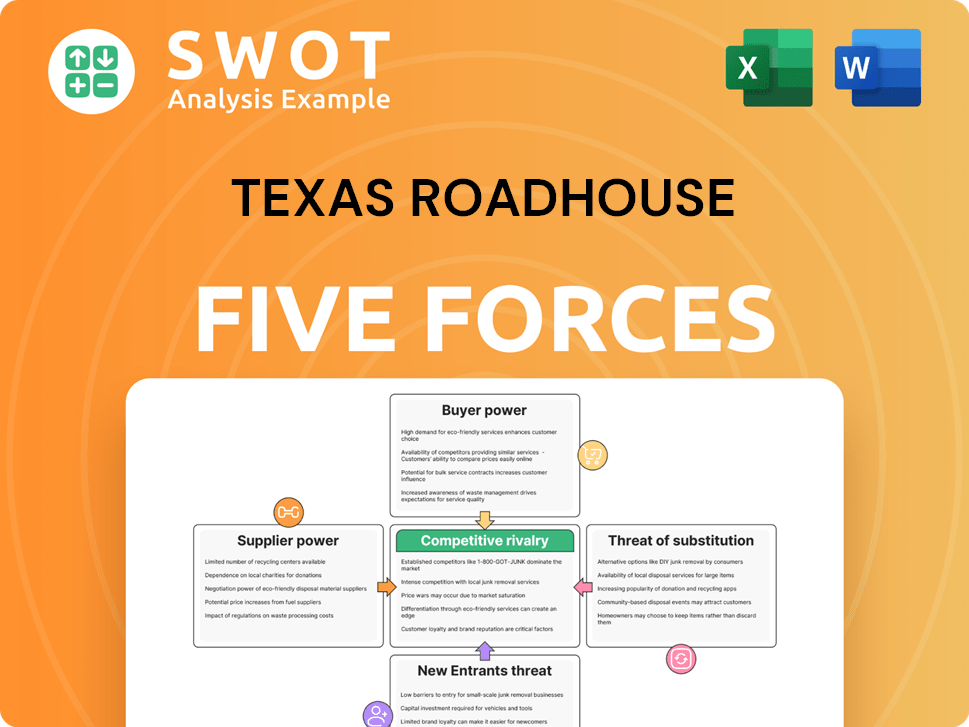Texas Roadhouse Bundle
Can Texas Roadhouse Maintain Its Steakhouse Dominance?
In a fiercely contested restaurant industry, Texas Roadhouse stands out, but how does it truly stack up against its rivals? Founded in 1993, the company has built a loyal following with its focus on quality, value, and a lively atmosphere. This article dives deep into the Texas Roadhouse SWOT Analysis and the competitive landscape, providing a comprehensive Texas Roadhouse market analysis.

Understanding the Texas Roadhouse competitive landscape is crucial for investors and industry watchers alike. We'll explore the company's main Texas Roadhouse competitors, evaluating their strengths and weaknesses. This analysis will help you understand the challenges and opportunities for Texas Roadhouse, including its expansion strategy and how it differentiates itself in the steakhouse competition.
Where Does Texas Roadhouse’ Stand in the Current Market?
The company maintains a robust market position within the casual dining sector, particularly in the steakhouse and American cuisine categories. Its success is evident in its consistent ranking among top performers in terms of sales volume and customer traffic. This strong performance highlights the effectiveness of its strategies in a competitive market.
The company's core operations center around its hand-cut steaks, ribs, and made-from-scratch sides. This focus caters to a broad customer segment that values quality, generous portions, and a lively, family-friendly atmosphere. Its strategic emphasis on value and quality has helped maintain strong customer loyalty, even amidst economic pressures.
Geographically, the company has a significant presence across the United States, with ongoing expansion into both domestic and international markets. In Q4 2023, the company reported an 8.6% increase in comparable restaurant sales at company-owned restaurants, demonstrating strong customer demand and effective pricing strategies. The company's ability to adapt and thrive in various markets underscores its resilience and strategic foresight.
The company consistently ranks among the top performers in the casual dining segment. While specific market share figures fluctuate, its sales volume and customer traffic remain strong. This performance is a key indicator of its competitive advantage within the restaurant industry Texas.
In 2023, the company reported total revenues of $4.65 billion. This substantial increase from previous years highlights its financial health and scale. This financial strength allows for continued investment in expansion and customer experience.
The company has maintained strong customer loyalty, even amidst inflationary pressures. Its focus on value and quality has been a key factor in retaining customers. This customer loyalty is crucial in the competitive steakhouse competition.
The company has a significant presence across the United States, with continued expansion into new domestic and international markets. This expansion strategy is a key element of its long-term growth plan. This expansion strategy and competition are key factors.
The company's competitive advantages include its focus on high-quality food, generous portions, and a family-friendly atmosphere. These factors differentiate it from competitors and contribute to its strong market position. Understanding the Texas Roadhouse SWOT is essential.
- Strong brand recognition and customer loyalty.
- Effective pricing strategies and value proposition.
- Consistent financial performance and revenue growth.
- Strategic expansion into new markets.
Texas Roadhouse SWOT Analysis
- Complete SWOT Breakdown
- Fully Customizable
- Editable in Excel & Word
- Professional Formatting
- Investor-Ready Format

Who Are the Main Competitors Challenging Texas Roadhouse?
The Texas Roadhouse competitive landscape is shaped by a diverse range of rivals, spanning both direct and indirect competitors within the restaurant industry. Understanding these competitors is crucial for a thorough Texas Roadhouse market analysis and assessing its position in the steakhouse segment. The company faces ongoing challenges and opportunities influenced by market trends, consumer preferences, and strategic moves by its competitors.
Texas Roadhouse competitors are primarily other full-service steakhouses and casual dining chains. These rivals compete on menu offerings, pricing, customer service, and marketing strategies. The competitive environment also includes a broader range of restaurants, which adds complexity to the market dynamics.
The restaurant industry is highly competitive, with companies constantly vying for market share. This competition influences everything from menu innovation to pricing strategies. To succeed, companies must differentiate themselves and adapt to changes in consumer behavior and economic conditions.
Direct competitors include steakhouses and casual dining restaurants that offer similar menus and price points. These rivals compete for the same customer base, focusing on steaks, side dishes, and a casual dining experience.
Outback Steakhouse, a subsidiary of Bloomin' Brands, is a major direct competitor. It is known for its Australian-themed casual dining experience and competes directly with Texas Roadhouse. Outback's marketing and loyalty programs are key strategies.
LongHorn Steakhouse, part of Darden Restaurants, is another significant direct competitor. It focuses on grilled steaks and a Western-themed ambiance, aiming to attract a similar customer base. LongHorn's menu and pricing strategies are critical.
Indirect competition comes from a broader range of restaurants, including casual dining and fast-casual concepts. These establishments offer diverse menus and compete for a share of the dining-out market. Local independent restaurants also pose a challenge.
Other casual dining restaurants offer diverse menus, competing for customers looking for various dining experiences. These restaurants may not specialize in steaks but still attract customers. They compete through menu variety and pricing.
Fast-casual restaurants emphasize speed and convenience, appealing to customers seeking quick meals. These establishments offer a different dining experience but compete for a share of the overall dining market. They focus on efficiency and value.
Several factors influence the Texas Roadhouse competitive landscape. These include menu innovation, pricing strategies, marketing campaigns, and customer loyalty programs. Understanding these factors is crucial for analyzing the company's market position and developing effective strategies.
- Menu Innovation: Introducing new menu items and seasonal offerings helps attract and retain customers.
- Pricing Strategies: Competitive pricing is essential for attracting customers and maintaining profitability.
- Marketing Campaigns: Effective marketing campaigns help build brand awareness and drive customer traffic.
- Customer Loyalty Programs: Loyalty programs incentivize repeat business and foster customer relationships.
- Location Strategy: Strategic location choices impact accessibility and market penetration.
For more detailed insights into the financial aspects of the company, including ownership and shareholder information, you can explore Owners & Shareholders of Texas Roadhouse.
Texas Roadhouse PESTLE Analysis
- Covers All 6 PESTLE Categories
- No Research Needed – Save Hours of Work
- Built by Experts, Trusted by Consultants
- Instant Download, Ready to Use
- 100% Editable, Fully Customizable

What Gives Texas Roadhouse a Competitive Edge Over Its Rivals?
The Growth Strategy of Texas Roadhouse is built on several key competitive advantages. These strengths have allowed the company to maintain a strong position within the restaurant industry. Central to its success is a commitment to quality, value, and a unique dining experience that sets it apart from its competitors.
One of the primary competitive advantages of Texas Roadhouse is its focus on fresh, high-quality ingredients. The hand-cut steaks, prepared in-house, are a significant draw for customers. This emphasis on scratch-made food and generous portion sizes provides a perceived value that resonates with its customer base. The lively, energetic atmosphere, characterized by line dancing servers and popular music, creates a unique dining experience that differentiates it from more traditional casual dining establishments.
Furthermore, the company benefits from strong brand equity and customer loyalty. Its 'Legendary Food, Legendary Service' mantra has fostered a loyal following, leading to consistent traffic and repeat business. Texas Roadhouse also leverages economies of scale in its purchasing and distribution, allowing it to maintain competitive pricing while upholding food quality.
Texas Roadhouse's commitment to fresh, high-quality ingredients, especially hand-cut steaks, is a key differentiator. This focus on scratch-made food enhances customer perception of value. The company's dedication to quality contributes to its strong brand reputation.
The lively atmosphere, with line dancing servers and popular music, creates a memorable dining experience. This distinctive environment attracts customers seeking more than just a meal. It fosters customer loyalty and repeat visits.
The 'Legendary Food, Legendary Service' mantra has built a loyal customer base. This loyalty translates into consistent traffic and repeat business. Strong brand recognition helps Texas Roadhouse maintain a competitive edge.
Texas Roadhouse leverages its size to achieve economies of scale in purchasing and distribution. This allows the company to maintain competitive pricing. Efficient operations contribute to its strong financial performance.
Texas Roadhouse's competitive advantages include its focus on quality ingredients, a unique dining atmosphere, strong brand loyalty, and operational efficiency. These factors have allowed the company to maintain a strong position in the competitive steakhouse market. The company's disciplined approach to real estate selection and its focus on operational efficiency contribute to its strong financial performance.
- Hand-Cut Steaks: Prepared in-house, ensuring freshness and quality.
- Unique Atmosphere: Lively and energetic, creating a memorable dining experience.
- Customer Loyalty: Fostered by consistent service and quality.
- Operational Efficiency: Economies of scale and disciplined real estate selection.
Texas Roadhouse Business Model Canvas
- Complete 9-Block Business Model Canvas
- Effortlessly Communicate Your Business Strategy
- Investor-Ready BMC Format
- 100% Editable and Customizable
- Clear and Structured Layout

What Industry Trends Are Reshaping Texas Roadhouse’s Competitive Landscape?
The casual dining sector is currently influenced by evolving consumer preferences, technological advancements, and inflationary pressures. The need for value, convenience, and unique dining experiences is rising, which presents both challenges and opportunities for understanding the Growth Strategy of Texas Roadhouse. A significant challenge is managing rising food and labor costs, which can impact profitability if not balanced with pricing strategies. The increasing demand for off-premise dining also presents an operational challenge.
However, these trends also present significant opportunities. Texas Roadhouse can capitalize on its strong value proposition to attract budget-conscious consumers. Further investment in technology, such as online ordering platforms and loyalty programs, can enhance convenience and strengthen customer engagement. Expanding into new domestic and international markets, particularly in underserved areas, offers substantial growth potential. Innovation in menu offerings, while staying true to its core concept, could also attract new customer segments. The company's competitive position is likely to evolve with its continued focus on operational excellence, strategic expansion, and adaptation to changing consumer behaviors, aiming to remain resilient amidst industry shifts.
The restaurant industry is experiencing a shift towards digital ordering and delivery services. Consumers are seeking more convenience and value, leading to increased demand for takeout and off-premise dining options. Inflation continues to impact food and labor costs, requiring restaurants to adjust pricing and operational strategies to maintain profitability.
Managing rising operational costs, including food and labor, is a significant challenge for Texas Roadhouse. Maintaining food quality and service standards in off-premise dining is crucial. Adapting to changing consumer preferences and increasing competition from both casual and fast-casual restaurants is essential for sustained growth.
Texas Roadhouse can leverage its strong brand reputation and value proposition to attract budget-conscious consumers. Expanding into new markets, both domestically and internationally, offers significant growth potential. Investing in technology, such as online ordering and loyalty programs, can enhance customer engagement and convenience.
The company's focus on providing a high-quality dining experience at a reasonable price point differentiates it from competitors. Its strong brand loyalty and customer service are key factors in its success. Strategic expansion into new markets and innovative menu offerings can attract new customer segments.
To thrive in the evolving restaurant industry, Texas Roadhouse must focus on operational efficiency, strategic expansion, and customer engagement. Adapting to consumer preferences by offering convenient services like online ordering is also essential. The company’s ability to manage costs while maintaining quality will be crucial.
- Prioritize cost management to maintain profitability, especially in the face of inflation.
- Invest in technology to enhance the customer experience and streamline operations.
- Explore new market opportunities, both domestically and internationally, to drive growth.
- Continuously innovate menu offerings to attract and retain customers.
Texas Roadhouse Porter's Five Forces Analysis
- Covers All 5 Competitive Forces in Detail
- Structured for Consultants, Students, and Founders
- 100% Editable in Microsoft Word & Excel
- Instant Digital Download – Use Immediately
- Compatible with Mac & PC – Fully Unlocked

Related Blogs
- What are Mission Vision & Core Values of Texas Roadhouse Company?
- What is Growth Strategy and Future Prospects of Texas Roadhouse Company?
- How Does Texas Roadhouse Company Work?
- What is Sales and Marketing Strategy of Texas Roadhouse Company?
- What is Brief History of Texas Roadhouse Company?
- Who Owns Texas Roadhouse Company?
- What is Customer Demographics and Target Market of Texas Roadhouse Company?
Disclaimer
All information, articles, and product details provided on this website are for general informational and educational purposes only. We do not claim any ownership over, nor do we intend to infringe upon, any trademarks, copyrights, logos, brand names, or other intellectual property mentioned or depicted on this site. Such intellectual property remains the property of its respective owners, and any references here are made solely for identification or informational purposes, without implying any affiliation, endorsement, or partnership.
We make no representations or warranties, express or implied, regarding the accuracy, completeness, or suitability of any content or products presented. Nothing on this website should be construed as legal, tax, investment, financial, medical, or other professional advice. In addition, no part of this site—including articles or product references—constitutes a solicitation, recommendation, endorsement, advertisement, or offer to buy or sell any securities, franchises, or other financial instruments, particularly in jurisdictions where such activity would be unlawful.
All content is of a general nature and may not address the specific circumstances of any individual or entity. It is not a substitute for professional advice or services. Any actions you take based on the information provided here are strictly at your own risk. You accept full responsibility for any decisions or outcomes arising from your use of this website and agree to release us from any liability in connection with your use of, or reliance upon, the content or products found herein.